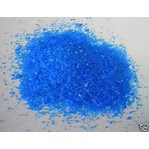
For our groups procedures, we kept all of the variables the same except for the one we were testing, in order to make sure the that change in results is because of the change on the variable that we controlled. For example, the first part of the lab was to determine how the size of the crystal effected the solution formation. By testing three different sized crystals of copper sulfate at the same temperature, our group got the conclusion that the larger the crystal, the longer it takes for it to dissolve.
The second part of the lab was to test the effect of the temperature of the solvent on the formation. Our group used water at three different temperatures and the same amount of copper sulfate, and by dissolving copper sulfate in all of them, we discovered that if the temperature is higher, the crystals will dissolve faster.
The last part of the lab was to test the effect of the degree of mixing on the formation the of the solution. To test this, our group mixed the solution with a stirring rod at different speeds but the same amount of copper sulfate and at the same water temperature. By keeping time, our group found that the faster you stir, the faster the crystals will dissolve.
So, that is pretty much it for our shortened class.
The conclusion part of the lab is for homework and it is due on Thursday.
The next scribe will be Michelle T.
The next scribe will be Michelle T.


No comments:
Post a Comment